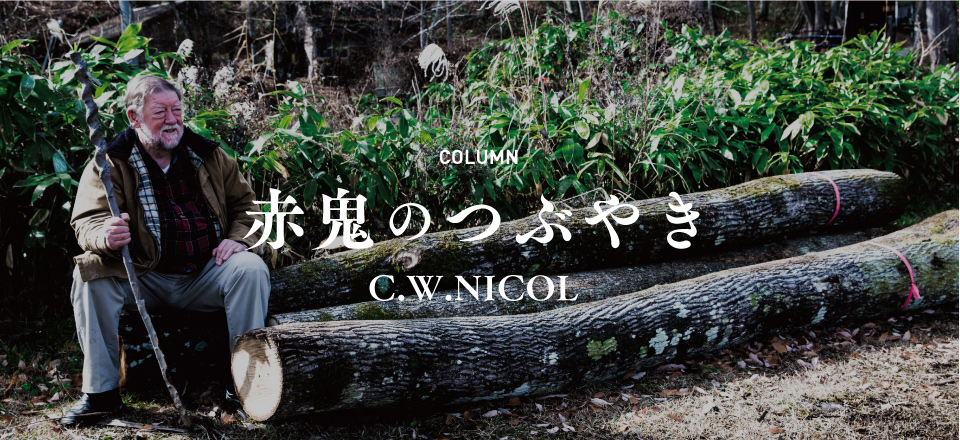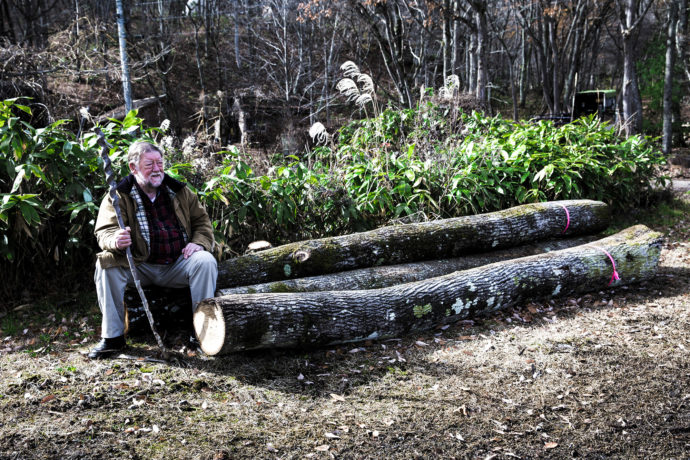Column
【赤鬼のつぶやき C.W.ニコル】ヌルデ(Sumac)

アファンの森では、今年の秋に立ち枯れていたヌルデの木を伐りました。幹の太さは60センチメートルです。よく燃えるので薪にしますが、この木を燃やすときにわたしが思い出すのは、炉に重ねたヌルデの枝を燃やしながら深く朗々と経を唱える僧侶のことです。聖徳太子として知られる厩戸皇子とゆかりがあると言われています。ヌルデの木から四天王の仏像を掘り出し、もし戦いに勝ったら寺を建てて仏教を布教すると約束して祈りを捧げたそうですが、この話を続けるには何ページも必要になってしまいます!
冬になるとヌルデの枝には真っ赤な実が房になって成り、幸運を招く装飾として用いられます。
そして日本では漆としても知られています。この木から塗装に使われるウルシオールという毒のある樹液が採れるのです。
ヌルデの仲間には35種類があります。温帯と亜熱帯のうち、特に東アジアとアフリカ、北アメリカに分布しています。数多くの歴史上の伝説や民話に登場していて、それだけで一冊の本が書けるような気がします。アファンの森にも10メートルほどの高さの木がありますが、20メートルほどになることもあるようです。あまり高くまで成長しない灌木のようです。葉軸に7枚から19枚の大きな葉が付きます。緑がかったクリーム色の小さな花が、円錐の形にたくさん密集して咲きます。鳥が種子を拡散するほか、茎が分岐したり、地下茎でも繁殖します。

中東では、干したヌルデの実に粉をまぶして食べます。赤く、渋みと酸味もあるスパイスになり、色々な料理に使います。ブリティッシュコロンビアに暮らしている娘のみわこが送ってきてくれるヌルデの実は、地元で集めて加工されたもので、現地料理の味付けにもよく使われるようです。魚やチキン、アヒルによく合うほか、オリーブオイルと塩をかけるとサラダや野菜料理の香りが引き立ちます。タネから油をとってロウソクを作る地域もあります。ネイティブアメリカンは水に果実をつけてスマケードという飲み物を作って楽しみます。葉は乾かして葉巻にして儀式に用いたり、果実や種、葉はアジアや中東では伝統医療の薬や、染料としても大切にされてきたのです。
聖徳太子がこの木に彫刻を施したなら、間違いなく他にも同じことをした人がいたはずです。木材を乾燥させてヌルデには肌をかぶれさせる性質がありますが、しっかり木材の樹液を乾燥させるなど加工して、いろいろな用途に使われていたに違いありません。
2017年12月
C.W. ニコル
写真提供:C.W.ニコル・アファンの森財団
SUMAC – NURUDE (Toxicodendron verniciflum)
This autumn we cut down some standing dead sumac trees in our woods. The trunks were about 60 cms. In diameter and the well-dried wood will make excellent firewood. When I think of burning this wood I think of the Buddhist ceremonies in which a roaring fire is made of carefully piled sticks of sumac wood while monks chant in deep, sonorous voices. The tree is associated with Umayado no Miko, more commonly known as Prince Shotoku (AD 574 to 622) who is supposed to have cut a sumac and from its trunk carved four guardian kings, the Shitenno, and vowed to build a pagoda temple and to promote Buddhism if his army won a victory – but to go on about that would take several pages!
In the winter branches of these ‘nurude’ trees, with their dense red cluster of little fruits or ‘drupes’ are brought into Japanese homes as good luck decorations.
This sumac is also known as the Japanese lacquer tree, because if cut the bark exudes a toxic sap containing urushinol, used as a lacquer.
There are about 35 species of the sumac tree growing in temperate and subtropical regions all over the world but especially in East Asia, Africa and North America. It is an amazing tree, linked to so much history and folklore that I could write a whole book about it. In our woods it grows about 10 metres tall, but in some places it can reach 20 metres. It is not a big tree, and in some areas it is small enough to be considered a shrub. It has large leaves with 7 to 19 leaflets. The tiny, greenish, creamy white flowers grow in dense spiky clusters. Birds spread the seeds, but this tree also grows new green shoots or rhizomes from its roots.
In the Middle East especially dried and powdered sumac fruits are used as a red, tangy, slightly lemony spice in all kinds of cookery. I myself use this spice that my older daughter Miwako sends to me from British Columbia where it is gathered, dried and powdered by coastal native folk to flavor traditional native dishes. Sumac spice is great with fish, chicken, duck, or mixed with olive oil and a little salt to flavor salads and other vegetable dishes. In some areas the seeds make wax for candles. Native Americans brew a refreshing beverage, sometimes called ‘sumacade’ by soaking the fruits in cold water. They also smoke the dried leaves in their ceremonial peace pipes. Sumac fruits, nuts and leaves have long been used in traditional medicine throughout Asia and the Middle East, and it was also used as a dye.
If Prince Shotoku used it to carve sumac wood then I’m sure that so did others, and the wood probably has many uses once you dry it and deal with the tendency to cause rashes.
C.W.Nicol
December 2017
C.W.ニコル
作家・1940年イギリス南ウェールズ生まれ。1995年日本国籍取得。カナダ水産調査局北極生物研究所の技官・環境局の環境問題緊急対策官やエチオピアのシミエン山岳国立公園の公園長など世界各地で環境保護活動を行い、1980年から長野県在住。1984年から荒れ果てた里山を購入し「アファンの森」と名づけ、森の再生活動を始める。2005年、その活動が認められエリザベス女王から名誉大英勲章を賜る。2011年、2016年に天皇、皇后両陛下がアファンの森をご視察された。





